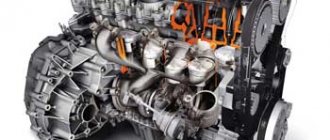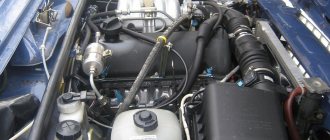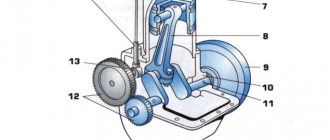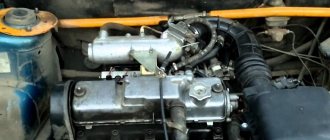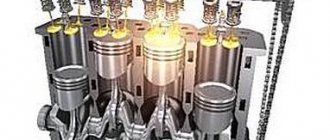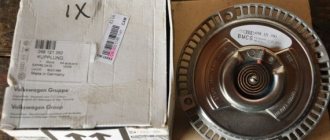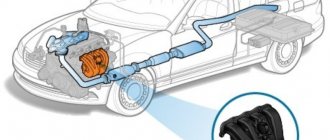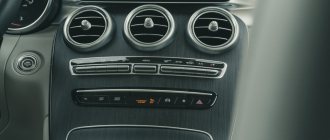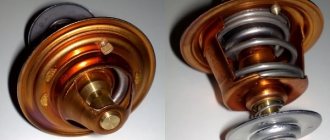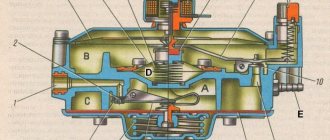| page | 7/7 |
| date | 29.01.2018 |
| Size | 106.98 Kb. |
| File name | Car engine power supply system.docx |
| Type | Laboratory work |
7
| Injection engine power supply system So, in our time, the model of injection engines has become widespread in cars, so we also need to consider the power supply system of an injection engine. A distinctive feature of injection engines is the absence of a carburetor, which is replaced by new, modern elements of the engine power system. Another advantage is that the driver, by pressing the gas pedal, regulates only the air flow entering the cylinders, and the composition and quality of the resulting working mixture is controlled by the on-board computer built into the system. The very principle of operation of the on-board computer of the injection engine power supply system is presented below. Here the process of obtaining the fuel-air mixture has been changed. Thus, the fuel pump, instead of a mechanical one, has become electric and is located directly in the fuel tank of the car. In addition, it supplies fuel to the system immediately under high pressure. The fuel enters the fuel rail in which the injectors are located. Through them, gasoline is injected directly into a specific cylinder at a given time, where it is mixed with air. How much fuel needs to be supplied to a specific cylinder and at the right time is determined by this same on-board computer. This is affected by the volume of incoming air, its and engine temperature, crankshaft rotation speed, etc. By reading all these indicators, the computer program calculates the time interval at which the valve on each injector is activated, allowing gasoline under pressure to enter the engine cylinders. This is how the fuel supply in the fuel injection system is automatically controlled. If the internal combustion engine is called the “heart” of the car, then here we are faced with its “brain”. The advantages of such systems are obvious: saving on consumption, reducing toxicity, increasing the service life of the engine and more rational use of it during operation. But there is also a minus - this is the complication of the design of the injection engine power system itself due to the increase in electronic devices, which can be very “capricious” with temperature changes, increased humidity and significant fluctuations during long-term driving on uneven terrain (off-road). However, designers have also found ways to minimize the risk of malfunctions in such situations. The design of the injection engine power system is presented below. Here you can see blue arrows showing the direction of exhaust gases. Thus, from the design of the injection engine power supply system we have reached the exhaust gas exhaust system. What is she like? We return again to the engine cylinder. After completing the power stroke of the piston, the exhaust stroke begins as the piston moves from BDC to TDC. At the same time, the exhaust valve opens and gases are removed from the cylinder. This whole process is accompanied by loud noise, and the gases themselves are accompanied by a high rate of release, temperature and toxicity. To comprehensively solve all these problems, the car is equipped with an exhaust gas system. Gases from the cylinder through the exhaust manifold enter the converter, which acts as a filter, and then into the muffler. The muffler has several chambers connected in series with holes. This whole structure looks like a coil. The flow of gases, passing through the chambers, constantly changing direction, is muffled, that is, the noise and their temperature are reduced. After which they are released into the atmosphere through the exhaust pipe of the car. To complete the acquaintance with the injection engine power supply system and exhaust gases, it is worth mentioning this nuance. We have found that if there is no air or fuel supply, the car engine will not start or will stall if the supply of one of the components is interrupted. But if you shut off the exhaust gases, the result will be the same. The engine will stall because no vacuum will be created in the cylinder. This means that neither new air flow nor fuel will enter it. This has found its application in industrial power plants in production, when it is necessary to emergency stop the operation of the internal combustion engine. Closing the exhaust pipe reliably guarantees this. Federal state budget educational Octane number Fuel tank Air filter Operation of the engine power system Operating modes of the engine power system Share with your friends: |
Direct injection
Injection cars with such systems can be considered the most environmentally friendly. The main purpose of introducing this injection method is to improve the quality of the fuel mixture and slightly increase the efficiency of the vehicle engine. The main advantages of this solution are as follows:
Close the fuel valve to the injector. Open the fuel control valve to obtain a reading. 5. Make sure the fuel control valve to the pressure gauge is closed to prevent damage to the gauge in case of sudden overpressure. Install the most suitable pressure pipe for testing the injectors. Use a little force to operate the hand pump lever.
Using a flat head screwdriver and wrench. following the steps above. opening pressure is calibrated. 6. Remove the injector from the high pressure pipe and from the test chamber. Got it. The hand pump operates until the injector reaches opening pressure. Once the injector is removed, tests are carried out with other injectors. Then. we check this pressure when we work with a hand pump and the pressure gauge shows approximately an opening pressure of 350 bar. up to 380 bar. It is then pumped several times higher than the opening pressure to check if the spray quality is optimal. up to a pressure of 350 bar.
- thoroughly spraying the emulsion;
- formation of a high-quality mixture;
- effective use of emulsion at various stages of internal combustion engine operation.
Based on these advantages, we can say that such systems save fuel. This is especially noticeable during quiet driving in urban conditions. If we compare two cars with the same engine size, but different injection systems, for example, direct and multipoint, then the direct system will have noticeably better dynamic characteristics. The exhaust gases are less toxic, and the liter power taken will be slightly higher due to air cooling and the fact that the pressure in the fuel system is slightly increased.
But it is worth paying attention to the sensitivity of direct injection systems to fuel quality. If we take into account the standards of Russia and Ukraine, the sulfur content should not exceed 500 mg per 1 liter of fuel
At the same time, European standards imply a content of this element of 150, 50 and even 10 mg per liter of gasoline or diesel.
If we briefly consider this system, it looks like this: the injectors are located in. Based on this, injection is carried out directly into the cylinders. It is worth noting that this injection system is suitable for many gasoline engines. As noted above, high pressure is used in the fuel system, under which the emulsion is supplied directly into the combustion chamber, bypassing the intake manifold.
Types of mechanical injectors
General concept
Any fuel system is designed for uninterrupted supply of a combustible mixture to the engine combustion chambers. In our case, injection or forced injection of gasoline is carried out by a mechanical injector. It is possible to track changes in any of the parameters necessary for preparing the air-fuel mixture using mechanical signal transmission. In addition, the necessary calculations and implementation of control laws (mixture formation) are carried out using mechanical devices. The use of electrical signals in this system is minimized, and sometimes completely eliminated. A mechanical injector was used on Audi 100 cars.
Knowledge of the principles of operation makes it easier to find and eliminate failures and malfunctions in any system, which, although difficult to adjust, is still subject to the skillful hands of a master who has a clear understanding of its structure and the laws of operation.
What types of mechanical injectors are there?
This system, like any device, did not remain constant in its design and underwent some changes over time. This is due to the desire of the car designers to make it better.
There are three main types of system:
- K-jetronic;
- KE-jetronic;
- KE3-jetronic.
As operating experience has shown, this not only did not improve, but, on the contrary, worsened performance indicators, which is why manufacturers were forced to abandon such modernization. K-jetronic is historically the first modification and excludes the presence of electronic devices as much as possible. KE- and KE3-jetronic are hybrids or varieties of K-jetronic, equipped with electronic devices.
Let's take a closer look at the design and operating principle of K-jetronic.
Selecting the optimal fuel supply system
Thinking about the difference between an injector and a carburetor, many motorists come to the conclusion that the electronic system is much more reliable. However, re-equipping any car is not economically profitable and will only lead to unnecessary costs. The decision to choose a more economical system is important when buying a car. It’s quite easy to understand the difference between an injector and a carburetor, and such knowledge will definitely come in handy.
The carburetor has already served its useful life in the modern car market. Despite its advantages, the use of an injector is most effective and meets all environmental requirements. Carburetor engines are used mainly on older cars, but this technology has proven itself and does not need modification. The use of an injector has considerable advantages and this system is installed without choice in any new car.
Fuel injection system running lean
A little higher, we looked at direct injection, which was first used on Mitsubishi cars, which had the abbreviation GDI. Let's take a brief look at one of the main modes - running on a lean mixture. Its essence lies in the fact that the vehicle in this case operates under light loads and moderate speeds of up to 120 kilometers per hour. Fuel injection is carried out by a torch in the final stage of compression. Reflecting from the piston, the fuel mixes with air and enters the spark plug area. It turns out that the mixture in the chamber is significantly leaner, however, its charge in the area of the spark plug can be considered optimal. This is enough to ignite it, after which the rest of the emulsion lights up. In fact, such a fuel injection system ensures normal operation of the internal combustion engine even at an air/fuel ratio of 40:1.
Carburetor vs injector
Perhaps the only fans of the carburetor are those who like to start at a traffic light. The reason is that the carburetor allows you to develop high torque and power at the bottom. An injection system, even a perfectly tuned one, is not close. The simplicity of the carburetor and the cost of maintenance also provide a slight advantage. But when it comes to power and torque at high speeds, the injector wins here, and by a large margin. In other words, when overtaking, your car will be more responsive if injection is installed. It is also possible to increase power by installing a turbine - a device capable of pumping excess air pressure into the injection system. Due to this, the engine power increases many times. Of course, the resource suffers, but what won’t you sacrifice for the sake of a spectacular ride?
Homogeneous mixture formation and 2-stage mode
Power mode (homogeneous mixture formation) is an ideal solution for aggressive driving in urban conditions, overtaking, as well as driving on highways and highways. In this case, a conical torch is used; it is less economical compared to the previous option. Injection occurs during the intake stroke, and the resulting emulsion usually has a ratio of 14.7:1, that is, close to stoichiometric. In essence, this automatic fuel supply system is exactly the same as the distribution system.
The two-stage mode involves fuel injection on the compression stroke and also on the start stroke. The main task is to sharply increase the engine. A striking example of the effective operation of such a system is driving at low speeds and sharply pressing the accelerator. In this case, the likelihood of detonation increases significantly. For this simple reason, instead of one stage, injection takes place in two.
At the first stage, a small amount of fuel is injected during the intake stroke. This allows you to slightly lower the air temperature in the cylinder. We can say that the cylinder will contain an ultra-lean mixture in a ratio of 60:1, therefore, detonation is impossible as such. At the final stage of the compression stroke, a jet of fuel is injected, which brings the emulsion to a rich emulsion in a ratio of approximately 12:1. Today we can say that such an engine fuel system has been introduced only for vehicles on the European market. This is due to the fact that Japan is not characterized by high speeds, therefore, there are no high loads on the engine. In Europe, there are a large number of highways and autobahns, so drivers are used to driving fast, and this puts a lot of stress on the internal combustion engine.
Settings
Perhaps there is only one thing more difficult than repairing a mechanical injector - its adjustment. Again, many motorists will say, “What’s so difficult about adjusting the unit? You tighten the quality and quantity screws until the engine starts working stably.” That’s right, but any incorrect action during the setup process can disrupt the operation of the mechanical injector so much that it will be impossible to start the engine. Considering this nuance of adjusting the unit, we categorically do not recommend doing it yourself. Anyway, it’s better to entrust the setup of a mechanical injector to a professional.
If the situation is hopeless, and you have to regulate the operation of the system yourself, then you should adhere to only one principle. To be more precise, we are talking about using the indicators recommended by the injector manufacturer. Note that for each unit formation and engine power, the settings of the mechanical injection system are different, so you should not deviate from them. In the case when you do not have the required indicators, it is better not to get involved in adjusting the device, especially if the car is still driving without any problems. We assure you that it is simply outrageous to upset a mechanical injector, but it is very difficult to set it up again. Do you need extra problems? Most likely no.
As you can see, a mechanical injector is a simple device, but it works according to a rather complex scheme. Whether it’s worth the risk and “fighting” with her - everyone will decide personally. Our resource ends here. We hope that the material presented today was useful to you and provided answers to your questions. Good luck on the roads and in repairs!
Source
Carburetor design
Carburetor - is the simplest type of device for supplying and spraying gasoline. The process of mixing fuel with air is performed mechanically, and adjusting the supply of the mixture requires careful adjustment. Thanks to the use of simple mechanisms, the carburetor system is easy to maintain. An experienced motorist can perform such repairs independently, which provides certain advantages in operation. For such operations, it is not difficult to purchase a repair kit, and all work is carried out with standard tools available in the car.
The carburetor is located on the intake manifold, and its design consists of a float and mixing chambers. To supply fuel, a spray tube is used, connecting the chambers to each other. Fuel is supplied to the float chamber using a gasoline pump, and a stable supply of gasoline is ensured by a needle filter and a float. The mixing chamber is also called the air chamber and consists of a diffuser, atomizer and throttle valve. When the pistons move, a vacuum is created, which ensures the suction of atmospheric air and gasoline. This mixing ensures stable engine operation.
Let's sum it up
With a carburetor, the car becomes a little “dumber”, accelerates poorly and has poor response when pressing the gas pedal. This is why most motorists are not too keen on the idea of installing a carburetor on a fuel-injected car. Before you make such a decision, remember what problems and problems constantly arise with the carburetor. This will take some of the pressure off your desire to make the car simpler, and will also show how important it is to respect the factory design of the car.
However, there are different situations. If the injector on your car constantly breaks down, it is better to replace it and get pleasant emotions from it than to continue to constantly repair it and try to establish normal operation of a virtually non-working unit. It must be said that in most cases, after the normal implementation of replacing an injector with a carburetor, car owners are satisfied with the result.
At one time, the only possible mechanism for forming the air-fuel mixture was a carburetor. Actually, this process is called carburetion. The device was constantly improved, its productivity increased. Two or even four carburetors were installed on powerful sports engines. However, this method has purely physical limits; moreover, the design has inherent disadvantages that cannot be eliminated:
- Dependence on the quality and purity of the fuel. Since gasoline is absorbed by the air flow (before an aerosol is formed), the diameter of the hole affects the quality of the mixture. The smaller it is, the more vaporous the cloud can be made. Accordingly, the combustion quality will be higher. The other side of the coin is that a small nozzle hole increases the likelihood of clogging;
- Effect of temperature. Cold gasoline evaporates worse, and less fuel enters the float chamber. This causes difficulty starting the engine at sub-zero temperatures;
- All adjustments are mechanical. Fine tuning is time-consuming and requires a certain level of skill. On modern models, an idle air solenoid valve is installed, but this does not fundamentally solve the problem.
Then a mechanical injector was invented, and all modern cars began to be equipped with a new system for forming a gasoline mixture. This device has much wider development horizons: electromagnetic, piezoelectric injectors, improvement of control programs.
Owners of old cars often think about installing an injector instead of a carburetor. Is it possible? It is necessary not only to change the module itself, it is necessary to modify the entire intake system of the engine.
Features of fuel equipment
The car has always been the object of attention of environmentalists. Exhaust gases are released directly into the atmosphere, which can cause pollution. Diagnostics of the fuel system showed that the amount of emissions due to incorrect mixture formation increases significantly. For this simple reason, it was decided to install a catalytic converter. However, this device showed good results only with a high-quality emulsion, and in case of any deviations, its effectiveness dropped significantly. It was decided to replace the carburetor with a more accurate injection system, which was an injector. The first options included a large number of mechanical components and, according to research, such a system became worse and worse as the vehicle was used. This was quite natural, since important components and working parts became dirty and failed.
The programmer applying power to the injector solenoid valve activates the atomizer. After disconnecting the power supply, injection is completed. The dose of injected fuel is proportional to the activation of the solenoid valve; however, it is independent of engine or injection pump speed.
Injector operation diagram
This reduces fuel consumption, ensures quieter engine operation and a lower content of hazardous substances in the exhaust gases. Their main advantage is their short switching time, approx. 0.1 ms. Its OK. ten times faster than with solenoid injectors. As a result, the injection start can be freely adjusted as well as the fuel dose volume, and multi-phase injection can be performed. The inertia of the solenoid injectors allowed one initial injection to shut off the combustion noise.
In order for the injection system to be able to correct itself, an electronic control unit (ECU) was created. Along with the built-in lambda probe, which is located in front of the catalytic converter, this gave good performance. It’s safe to say that fuel prices today are quite high, and the injector is good because it allows you to save gasoline or diesel. In addition to this, there are the following advantages:
A group of piezoelectric elements is used as an element that controls the operation of the injector. Thanks to this rapid activation, the intervals between injections can be shortened, making it easier to optimize engine performance. The amount of fuel, including a small dose of the initial injection, is measured very precisely, which is reflected in a reduction in fuel consumption. Before gasoline can burn in a piston engine, it must be vaporized and mixed with oxygen in the right quantities. This process is carried out either by a carburetor or a high pressure injection system.
- Increased engine performance. In particular, increased power by 5-10%.
- Improving the dynamic performance of the vehicle. The injector is more sensitive to changes in loads and itself adjusts the composition of the emulsion.
- The optimal fuel-air mixture reduces the amount and toxicity of exhaust gases.
- The injection system starts easily regardless of weather conditions, which is a significant advantage over carburetor engines.
Repair (tuning, adjustment) of mechanical injection KE Jetronic.
Oh, this jetronic, how much nerves it spent on its owners and servicemen, how much money was wasted, how many curses the German developers heard...
Mechanical injections, in particular KE3-Jetronic, have become notorious due to their complexity, capriciousness, incomprehensibility, non-repairability, high cost, etc. Numerous reviews on the Internet confirm this, but what if we say that mechanical injection, also known as jetronic, “spider” and “turtle” (yes, whatever they call it) is actually not as scary as it might seem? In this article we will try to analyze the main issues and important points regarding mechanical injection, whether it is worth buying a car with such an injection, how much the repair costs, how to set up the injection and, most importantly, how to diagnose it yourself.
Why not? Mechanical injection can be repaired without problems (with the right approach); in extreme cases, it can generally be replaced with electronic injection “Invent”, “Liscar” or “January”.
Let's consider a typical situation: You bought a car with mechanical injection, but then the first problems began, there can be a great variety of them: the car does not start or starts poorly, accelerates poorly, the speed fluctuates, black smoke comes from the exhaust, failures during acceleration, stalls while driving, twitches, consumes gasoline, and so on. What to do? We know how the carburetor works and how the electronic injector works, but this will not help us much here; a mechanical injector is completely different.
First of all, we need to make sure the quality of the fuel poured in and replace it if necessary. It is also worth checking the electrical part: ignition coil, armored wires, distributor. Next, you should make sure that there are no air leaks in the system; most often the “turtle” breaks or cracks and the car begins to behave strangely.
Most often in mechanical injection, parts such as the fuel pump, PND (Pressure Disk Potentiometer), coolant temperature sensor fail, and the fuel distributor (spider, dispenser) becomes dirty. Let's take a closer look.
A mechanical injector operates at a higher pressure than classic electronic injection, so even if the gas pump pumps gasoline and this is clearly audible, this does not mean that it is working properly; in fact, it may not pump up the required pressure and the car may not start at all or not develop momentum. Measuring the pressure produced by the fuel pump will help here.
The HDPE is a small board with graphite tracks, which can fray over time and the sensor will no longer give correct readings, as a result of which the car’s dynamics and idle speed may disappear, and the car may begin to accelerate itself (emergency mode). The HDPE is simply removed and tested with a conventional multimeter, and worn tracks can also be determined visually. If the HDPE is faulty, you can buy a new one, it costs 3,500 rubles, and many people install an HDPE emulator from Winners, such an emulator costs 6,000 rubles.
DTOZH (coolant temperature sensor) - if this sensor malfunctions, the car may begin to over-enrich the mixture and, as a result, black smoke will appear from the pipe, and the car may simply not start. You can try to remove the sensor chip and look at the reaction of the car, if the black smoke stops coming out - there is only one option, the sensor needs to be replaced, it is very inexpensive, but defects can occur.
Over time, your fuel distributor (dispenser) may become dirty, hence poor dynamics and incorrect engine operation. You can remove the injectors from the manifold and check the operation of the dispenser using the “filling” method: remove the corrugation (turtle), lift the pressure disc up and fix it, immerse all the injectors in identical containers and periodically turn on the ignition to check how much fuel is poured into each of the containers, if a large one is visible difference in the indicators, then you can start cleaning the dispenser. You can try to wash it indiscriminately, but as a rule this does not give a strong long-term effect, so you can disassemble it and wash it. You need to disassemble without fanaticism, otherwise you can tear the gasket that is located between the two halves of the dispenser (although this gasket can also be bought new). After assembly, you need to check the filling again.
Using the same method, you can check the condition of the fuel injectors; during operation, they should emit a dense fuel mist with a characteristic loud squeak; if the injector flows, streams, or creates drops, then it definitely needs to be replaced. Unfortunately, there is no point in flushing mechanical injectors, since their malfunction is of a mechanical nature, namely the breaking of the injector fuel needle seat. A new nozzle costs 2000-2500 rubles. You can buy a used one, but you should check it right away. By the way, there is a myth that new injectors have not been produced for a hundred years, but this is not true, new injectors can easily be found in existential catalogs and more.
Let's say you did a high-quality diagnosis and determined that your HDPE is faulty, and some fuel injectors are also faulty. The cost of repairs is already approaching 8-10 thousand rubles. In this case, you can think about installing electronic injection; such an injection can be assembled and installed even from a VAZ car and it will work better than the original mechanical one, and it will cost you about 8-15 thousand rubles. If you have a larger budget, then you should pay attention to electronic injections “Invent” and “Liskar”; they are more expensive, but much easier to install.
The content of the article:
Hello, dear car owners! Many still remember the times when our people's cars were the legendary Muscovites and Zhigulis.
And every self-respecting car enthusiast, armed with a wrench and a screwdriver, considered it his duty to adjust the carburetor of his car to suit himself.
Gasoline engines of modern cars are equipped with a fuel injection system. This system is completely tied to the electronic “brain” of the car and it is unlikely to be possible to debug its operation with a wrench and a screwdriver.
Today's car enthusiasts, who want to carry out most of the maintenance operations on their car themselves, have in their arsenal, along with keys and screwdrivers, computers with special software.
Self-adjustment of the injector
Having become the owner of a car with a fuel injection system, often not entirely new, most of us, during operation, begin to notice certain deviations in the engine’s operation that we would like to correct. Either we don’t have enough traction, or it seems to be eating more fuel than it should, or it doesn’t work smoothly. It is in such cases that adjustment of the injector is necessary.
To adjust the injector yourself, you need a laptop with installed software that matches the make of your car and a cable for connecting to the on-board computer. The on-board computer has its own firmware, the “brain” of the car, with the help of which all processes are controlled.
By connecting to the on-board computer, you will be able to observe the vehicle parameters, as well as any errors present. Having a certain amount of knowledge, you can easily remove errors yourself.
And with the help of non-standard firmware, which is now easy to obtain, you can make changes to the main firmware of the car’s on-board computer, and thus customize the dynamics of your iron friend.
Chip tuning: customizing the injector for yourself
Injector tuning or chip tuning is the modification of the electronic engine control system in order to obtain the greatest possible improvement in its performance characteristics.
On an experimental car, the factory software is refined and adapted to local fuel and specific weather conditions, and the fuel consumption settings are perfected.
And only then, using modified software, the injector of your car is configured.
As a result, your car will receive:
- fast start
- smooth running at low loads,
- smooth traction in high gears,
- reduction in fuel consumption by 0.5-3 liters per 100 km.
It is strongly recommended that you trust the settings of the injector to qualified specialists working with licensed software. Installing untested software may make you happy with your car's sporting performance, but not for long. Next, as a rule, follows expensive engine repairs.
Adjusting the idle speed on the injector
One of the executing organs of the engine is the idle speed controller (IAC), which is a stepper motor with a conical needle.
The IAC regulates the air supply to the engine, receiving commands from the on-board computer. It is its malfunctions that cause floating engine speeds.
Adjusting the injector idle speed is performed in the following order:
- disconnect the battery;
- remove the idle air control;
- rinse and blow out the landing channel with compressed air, disassemble the regulator, check the guide bushing and replace it if there is increased wear;
- visually inspect the needle and replace it if visible defects are detected;
- Use a tester to check the serviceability of the regulator winding and clean its contacts;
- install the regulator in place, connect the power connector, connect the battery;
- start the engine and check its operation in different modes;
The fuel injection system, despite its apparent complexity, is quite adjustable and customizable. With high-quality and timely maintenance, it will delight you with impeccable performance for many years.
How to adjust and configure the injector
Many people over 40 have not forgotten those times when the only cars in the country were Muscovites and Zhigulenkis. And every experienced motorist at that time considered it an honor to be able to adjust the carburetor to suit himself. With the release of injection cars, it would seem that the need for such a setting has disappeared, but this is not entirely true. The secrets of how to adjust the injector will interest many amateurs.
